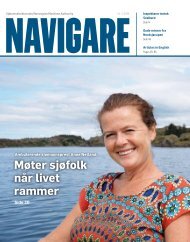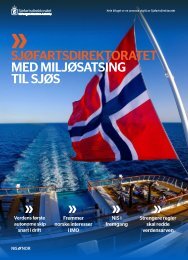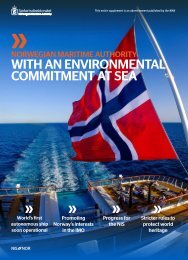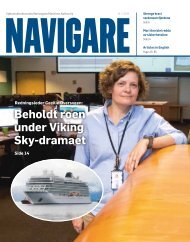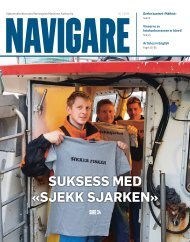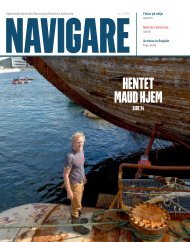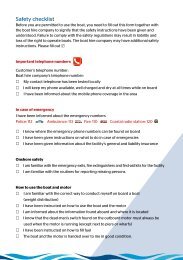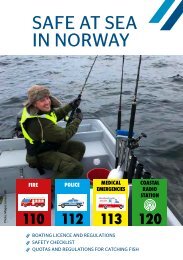You also want an ePaper? Increase the reach of your titles
YUMPU automatically turns print PDFs into web optimized ePapers that Google loves.
NEWS AKTUELT
ENGLISH TRANSLATION FROM PAGE 24
Aims for sustainable and safe activities in the north:
New Svalbard Regulations enter into force
“The Government will work to ensure sustainable activities in
and near Svalbard. We want to enhance safety and security
associated with increased ship traffic in the north. Therefore,
it is important that we establish new rules for passenger ships
operating in the waters of Svalbard,” the Minister of Trade and
Industry, Torbjørn Røe Isaksen, stated this in a press release
when the Norwegian government laid down new rules for
passenger ships in the territorial waters surrounding Svalbard
on 7 June. The Regulations enter into force on 1 January 2020.
JAN REINERT VESTVIK
Underavdeling passasjerskip, Sjøfartsdirektoratet
Svalbard is an archipelago in the Arctic and
has officially been part of Norway since 14
August 1925. It was the Dutch navigator
Willem Barentsz who in the summer of 1596
first caught eye of the pointed mountains,
“Spitz Bergen”, north-west on the island
now called Spitsbergen. People have lived in
Svalbard since the early 17th century and
traditionally, they have made their living
from fishing and later mining. Moreover, the
archipelago has attracted explorers and
adventurers from all over the world. At
present, Svalbard has approximately 2800
inhabitants, most of whom live in
Longyearbyen, Barentsburg and Ny-Ålesund.
Research and tourism are currently the main
industries. The Svalbard Treaty provides the
citizens of all signatory countries with equal
rights to live and engage in commercial
activities on the islands.
The Svalbard Treaty provides Norway
with the right to lay down requirements for
shipping, etc. if no monopolies or favours for
the benefit of any parties are established. “All
sections of the Regulations are based on the
Treaty. The same requirements apply to all
passenger ships regardless of their flag,” the
Norwegian Maritime Authority (NMA)
stated when the Regulations were adopted.
Serious ship accidents
Willem Barentsz and four of his crew
members never made it home after the
discovery of Svalbard. In the course of
history, there have been many serious ship
accidents in the Arctic. On 19 June 1989, the
passenger ship Maxim Gorkiy started to take
in water after a collision with floating ice
near Svalbard. About a thousand passengers
and crew members were evacuated to
lifeboats and ice floes. Fortunately, the
Norwegian Coast Guard ship Senja came to
the rescue only a few hours later.
“We find it positive that measures are
taken to improve shipping safety in
Svalbard,” the Ministry of Justice and Public
Security has declared in their consultative
statement to the new Regulations. The
Ministry has the overall responsibility for
search and rescue services. The Governor of
Svalbard supports the introduction of the
new Regulations: “There are changes to the
scope and type of traffic near Svalbard.”
In many cases, the need for wellconsidered
and explicit safety requirements
will be even stronger in the areas around
Svalbard than in other parts of Norway due
to the archipelago’s climate, location and
access to help in case of emergencies, etc.
Ships on international voyages
Ships engaged on international voyages are
required to have a certificate in accordance
with IMO Conventions, which implies that
all ships operating in polar waters must carry
a Polar Ship Certificate. Additionally, such
ships must comply with the requirements of
chapter 2 of the Regulations when visiting
Svalbard. This includes extended
requirements for voyage planning. Parts of
Svalbard are inadequately charted; large
areas are not charted at all or have been
measured using obsolete technology. The
master must consider the quality of the
58 | Navigare 4 - 2019









